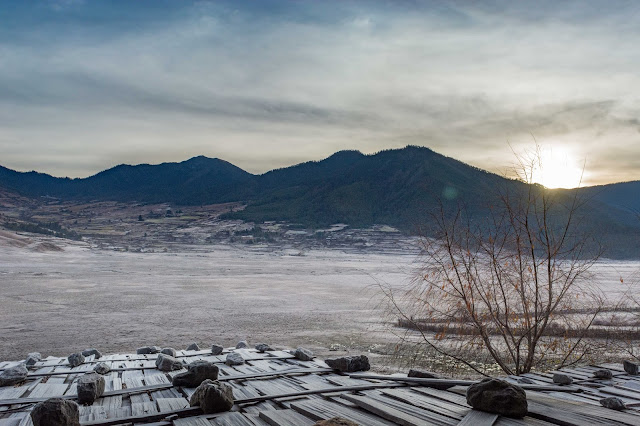Gangtey valley / Phobjikha
If you want to experience what it is to be wrapped by silence and serenity, try visiting Probhjikha valley in Bhutan. Situated at an altitude of about 3000m the Gangtey valley or Phobjikha is an absolute paradise, which also plays host to the migrating black neck cranes that fly from Tibet during the winter season.
I reached Gangtey at around 17:30 hrs on a Saturday in December. The sun was down and it was dark and eerily quiet. I was almost sure that I had lost my way. I stopped the car at a place which vaguely resembled a hotel. As I was anxiously wondering why this place did not have even a single light, a man approached me and told that the power was out in the whole valley and it would return in a moment... phew!
After a peaceful sleep, I woke up early, and to my amazement, the entire valley covered in white frost.
 |
| Frost covered Phobjikha valley |
 |
| Morning stroll along the village roads |
The Gangtey Monastery is accessible by road, but I decided to trek the route across the valley. Entering the valley is prohibited in most parts, so as to not disturb the cranes. This meant crossing the valley along its edges where the locals and officials have laid planks.
As it was winter, I could see a lot of these famous migrating cranes scattered all along the valley. The locals worship these birds and believe that they bring good fortune for the year's harvest.
The locals pointed out to the monastery in the distance and told me that during their flight from Tibet, just before entering the valley they encircle over the monastery three times.
The villagers also pointed out that the cranes never enter the many fields of potato and turnips which are right beside the valley. Only, after the harvest do they enter it and eat the left overs. There is a well designated national centre, the RSPN ( Royal society for the protection of nature) which monitors the activities of these birds.
The trek to the monastery is a short hike along the edges of the valley, a pleasantly easy one I would say! Being an off season, I was one of the REALLY FEW tourists at Gangtey that day.
 |
| A Stupa along the trail |
After coming out of the forest, the trail led me to a wider road passing through the Gangtey village. The road was lined on both sides by green fields of potatoes and turnips. The children and adults gave a warm smile as I passed by.
 |
| A stupa on the road through the village |
Just as I moved out of the village, I could see a small building housing a prayer wheel. To my surprise it was turning constantly, producing a pleasant ringing sound at constant intervals, but I could see no one turning it. Upon inquiry, I was told that the water from the stream is diverted to run the prayer wheel. hmmm ,,, that was impressive. 'Mani Kuchi' is what this is called in Bhutaneese!
 |
| A prayer wheel was turning inside powered by the water |
The route got a little bit more steeper after this till it joined the main road to the monastery, just in front of its gate.
 |
| The monastery gate |
A short walk from here led to the entrance of the monastery .
 |
| The monastery entrance |
The monks were always eager to narrate their history, culture and religious beliefs. Although the doors of the monastery were closed, little monk boys opened it and guided me inside. Not that this was the first monastery that I had visited, I was awestruck by the artistry and creativity in the sculptures and paintings inside. The paintings were exquisitely rich in color and done with intricate details.
I sat inside for a short while, soaking myself in the spirit of Buddhism after which I hiked back on the same path.
-------------------------------------------------------------------------------------------------------------------
How to reach: Gangtey has no connectivity by bus. On the way from Punakha to Bumthang, Gangtey is a slight detour . Buses will stop at this point, after which you are on your own. If lucky, you may get a lift from the locals.
Taxis can be hired from Punaka or Thimbu. Daily hire will cost about Rs. 2500-3000














Comments
Post a Comment